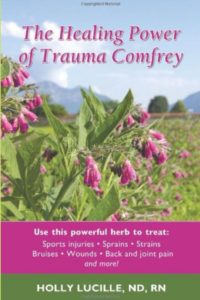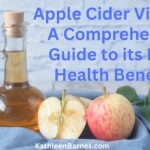Last Updated: June 28, 2019
 From The Healing Power of Trauma Comfrey by Holly Lucille, ND, RN
From The Healing Power of Trauma Comfrey by Holly Lucille, ND, RN
It’s that time of year—for bumps, bruises, sprains and all of the not–so-fun adjuncts to an active outdoor life.
If you’ve ever had a sprained ankle, a black-and-blue bruise or an aching back – and who hasn’t? — then you know how much suffering these injuries can cause. Even though they’re not life-threatening, they can make your days miserable with throbbing pain that seems to take forever to go away. Throughout the ages, we’ve endured the pain of these injuries unaware we could find quick relief with an amazingly potent herb that was close at hand: comfrey.
Way back when – as far back as 2,000 years ago – people would walk into a field or garden and reach for this plant with prickly leaves and purplish flowers. They called it by names like Knitback or Boneset, and it did exactly that – it knit broken skin and muscles and bones back together.
The common name Comfrey stems from the Latin word conferta, meaning “to unite.” Its official botanical name is Symphytum officinale: Symphytum means “to make grow together” and officinale refers to a monastery storeroom for botanical remedies, the pharmacy of its day. Its popular names also reveal its powers: Knitback, Bruisewort (wort meaning plant), Knitbone, Boneset.
A perennial herb, it belongs to the Boraginaceae family, which includes borage and forget-me-not. The plant is stout – about three feet high – and so thick that it’s difficult to grow anything underneath it. Its root is brownish-black and the width of a turnip; to propagate it, even a small piece of the root will do. Its roots dive deep, as far as 12 feet down, enabling it to bring to the surface the rich minerals of the subsoil. Its dark green leaves are tapered like a lance, are hairy and bristly to the touch, and can grow to 18 inches in length. Its flowers are delicate and bell-shaped, and they can be white, blue, pink, or purple.
What makes comfrey so special?
Here’s why comfrey is so powerful as a healer: It soothes pain, slows down further damage to tissues and fast-forwards the production of cartilage, tendons and muscles. It quickly and efficiently rebuilds damaged blood, bone and flesh. That’s precisely what is needed for injuries such as wounds, sores, burns, cuts, scrapes, bites, stings, rashes, swollen tissue, sprains and broken bones.
The most remarkable of comfrey’s healing ingredients is called allantoin. It’s known as a “cell proliferator” because it encourages cells to grow at a rapid rate – not in the chaotic manner of cancer cells, but in an orderly, orchestrated fashion. This makes wounds heal faster. It is also enhances white blood cell production to help ward off many types of infections and diseases.
Another clue to comfrey’s healing powers is the vibrant, dark green color of its leaves. That shows just how rich they are in chlorophyll, which scientists have found helps to rejuvenate old cells and accelerate the growth of new ones. Because its molecular structure resembles our blood, chlorophyll purifies blood, which speeds the healing process.
Comfrey also boasts a host of vitamins – strong doses of A, as well as B1, B2, B3, B5, B6, B12, C and E. It has 15 essential minerals, including calcium, phosphorus, potassium, chromium, cobalt, copper, magnesium, iron, manganese, sodium, boron, lead, sulphur, molybdenum, and zinc. Up to 35% of comfrey is protein, about as high a proportion as legumes, but it’s not a good idea to eat it or drink comfrey tea because some forms of comfrey have been associated with liver damage.
Although you might call allantoin the star player, all these components dance together in a complex choreography of healing. They interact with each other biochemically in hundreds of ways we have yet to understand, and the effect is to provide a balanced interplay of nutrients to the body to maximize the healing process.
Scientists have found that comfrey has many valuable properties:
- Anti-bacterial – Kills or slows down growth of bacteria
- Anti-exudative – Counters the oozing of fluid from cells and tissues as a result of inflammation or injury
- Anti-fungal – Fights fungus invaders such as yeast, mold and rot
- Anti-inflammatory – Prevents or reduces inflammation in cells
- Anodyne – Relieves pain
- Antiseptic – Kills or retards the growth of infection-causing microorganisms
- Astringent – Draws tissue together, thus restricting the flow of blood
- Alterative – Restores health functioning of the body
- Demulcent – Soothes pain in inflamed tissues, especially mucous membranes
- Emollient – Softens the skin
- Expectorant – Helps respiratory tract to expel phlegm and mucous
- Homeostatic – Helps the body balance internal and external stress
- Styptic – Arrests bleeding by constricting blood vessels
- Tonic – Invigorates and restores health
- Vulnerary – Heals fresh wounds
- Pectoral – Relieves chest and respiratory disorders
How can you use comfrey?
Unless you’re really excited about finding just the right variety, (a variety called trauma comfrey is best) puling those deep-rooted plants, grinding them with a mortar and pestle and heating them to just the right temperature, there’s a much easier solution.
From Kathleen: You can get it right out of a tube. I like the Terry naturally brand called Traumaplant comfrey cream.
I grow comfrey right in my garden and use the leaves liberally when I have an injury or insect bite. It’s highly effective!








Comfrey is an amazing herb and people should read about it in detail before making up their minds on it’s safety concerns.